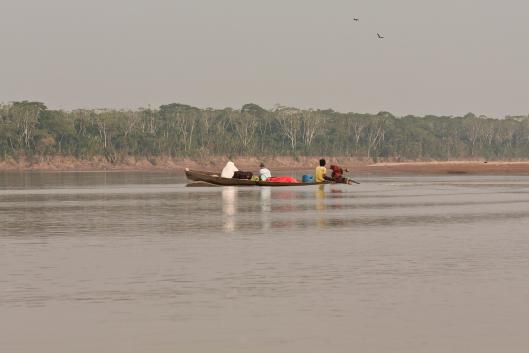On December 7 and 8, 2011, a meeting was held in the Amazonian city of Cobija, Bolivia, to assess the status of the rights of indigenous peoples living in isolation or in situations of extreme vulnerability in the Amazon and Gran Chaco regions, and to establish an action plan for the defence of their rights.
What follows is a summary of a report and reflections on the meeting written by Pablo Cingolani (the full text is available in Spanish athttp://www.ecoportal.net/Temas_Especiales/
Pueblos_Indigenas/Un_camino_hacia_la_proteccion_de_lo
s_pueblos_indigenas_en_aislamiento_de_Bolivia).
Over the last five years, in the framework of an impressive social and cultural mobilization, Bolivia has lived (and continues to live) through an era of changes. Today, like never before, the issue of the country's indigenous peoples – survivors of a genocide that began in the 16th century and an ethnocide that continues – is the subject of a debate that has been enriched and strengthened by a pluralistic human sensitivity, and with historical, present and future significance.
Sixty years ago, the nationalist process in Bolivia sought to integrate the indigenous peoples of the highlands and to dilute their identity through mestization and the creation of so-called agricultural syndicates. As for the indigenous peoples of the lowlands, their territories were subjected to a succession of tragic plans, over the course of decades, that implied the invasion and state/private control of their lands. Today, this conflict not only remains ongoing and unresolved, but has also become more ruthless, as it has been incorporated and creatively and contradictorily empowered in the new legal framework of rights – enshrined in the new Constitution – and in the permanent mobilization of social sectors that has marked the last decade of national life.
The meeting in Cobija, convened by the Confederation of Indigenous Peoples of Bolivia (CIDOB), was attended by representatives of (almost) all of the stakeholders involved in the issue of peoples living in isolation and in situations of extreme vulnerability, including the national government, the Ombudsman's Office, regional branches of CIDOB, and the Office of the United Nations High Commissioner for Human Rights, based in La Paz.
Numerous presentations and denunciations were heard about situations faced by peoples living in isolation, initial contact and extremely vulnerability. The focus of the meeting, however, was extensive discussion of the formulation of a minimum action plan for immediate and ongoing execution, in order to establish, for the first time in the country's democratic history, a visible and proactive agenda in defence of the rights of the most forgotten people of all.
The final declaration and plan of action recognized the urgent need for the adoption of a framework law for the defence and protection of indigenous peoples living in isolation, initial contact and a high degree of vulnerability. In this regard, the draft legislation developed by the Vice-Ministry of Justice of the Plurinational State of Bolivia was viewed as a positive step.
They also deemed it crucial to begin a process of demarcation and monitoring of all indigenous territories, but especially the territories inhabited by indigenous peoples living in isolation, initial contact and a high degree of vulnerability. This would effectively stop major infrastructure construction at the service of extractive and agro-industrial projects from continuing to claim victims, devour peoples and promote ethnocide and genocide.
A minimum action plan was established, which would entail: the demarcation and safeguarding of a reserve area for the Toromona and another one for the Pacahuara indigenous people, for the strict protection of these people and the prohibition of entry into their territory; the establishment of a special refuge area for segments of the T'simane indigenous population living in conditions of extreme vulnerability; a call for the creation of multidisciplinary and inter-institutional working commissions headed by CIDOB for the identification of other refuge areas for indigenous peoples or segments of indigenous peoples within the national territory, such as those inhabited by segments of the Araona, Chacobo, Yuqui, Mosetén, Ese Ejja and Yuracaré populations and others to be determined; and the creation of Ayoreo reserve areas to prevent any potential impacts on the Ayoreo people by prohibiting all types of hydrocarbon extraction and/or mining activities in their territories.
The final declaration concludes: “If almost three decades ago it was proclaimed that Bolivia could no longer live without its indigenous peoples, then today with the same force and the same conviction we proclaim that Bolivia and its Plurinational State can only exist as a full and dignified nation if it defends and protects its last indigenous peoples living in isolation, initial contact and a high degree of vulnerability in the Amazon and Gran Chaco regions.”
“Bolivia never again without its indigenous peoples living in isolation and situations of extreme vulnerability.”
